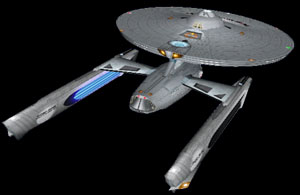
Ishtasse – aft dorsal starboard quarter
The Taal Tan Offensive of 2283 highlighted a lack of depth in Starfleet in the area of patrol cruisers. During this conflict all the Constitution-class heavy cruisers, their variant designs, and current light cruisers were all redeployed as offensive units despite any lack – perceived or actual – in their tactical capabilities. This left unattended the myriad duties that these ships covered.
As a result, many duty stations were taken over by vessels too small, under-powered, or otherwise unsuited or unsuitable to the tasks needed by these duty stations, leading to the loss of some of them to the weapons of bigger and badder pirate ships, and to some duties not being performed at all because of the limited available resources being stretched past their safety or even breaking point.
Thus the need for more cruisers was revealed. The options presented to the Starfleet Military Staff Committee to address this shortage were:
It was immediately understood that the de-militarisation of a class specifically geared towards combat manoevreability and survivability with the highest physical and tactical specifications was a waste of a much needed combat capable hull, and so The Belknap Family™ option was quickly discarded despite pressure from Massive Dynamic’s lobbyists. Amongst other reasons given it was felt that Cosmadyne’s shipyards were already at or exceeding their maximum capacity with the building of the second batch of Belknap and Ascension classes.
More Mirandas were seen as a desirable outcome for the Fleet, as these versatile, adaptable, and relatively quick-to-construct vessels were always in demand as a “mini-Constitution” for the Federation’s interior sectors. These built-up heavy frigates almost had the range and capacity of a true cruiser but this time their sheer versatility counted against them. Too often already the Mirandas were pulled off their scheduled route for urgent tasks or missions outwith their patrol duties, again leaving these roles uncovered.
It was decided then that a new design of patrol cruiser was needed to suit the role. With the envisioned mission profile the requirements put forth for this new cruiser’s design were:
Requirements for what the ship should NOT be were also clearly stated:
These latter two “anti-requirements” were specifically stated to reduce the resource expenditure on the vessels and ensure faster completion times by reducing the time needed for complex systems integration that comes from highly sophisticated tactical systems. Further, in being under-armed for their size and engine power they were precluded from being called in as the local policemen for emergencies.
Specifications within the requirements were further developed:
With these requirements in hand, it became clear that this new vessel would in essence be a “cut-down” Tikopai-class large exploratory cruiser. For this patrol cruiser there was no need for a full five-year endurance for independent missions in remote sectors.

Ishtasse – aft dorsal starboard quarter |
From these requirements was born the Ishtasse-class cruiser. In many ways she resembles her Tikopai-class older sister, but it is obvious just how retooled that design has been. While the most apparent difference is the re-positioning and different carriage of her warp nacelles, also obvious is the z-axis compression of the design and in particular the shortening and flattening of the secondary hull, now almost hidden between the vessel’s warp nacelles.
With this compression and the simpler hull structures and superstructures it has given rise to, comes a vessel which is extraordinarily sturdy and durable, despite its deliberate lack of offensive punch and defensive strength. Already proven to be a tough, hardworking ship perfectly suited to her duties and role within the Fleet, Starfleet commissioned a couple of feasibility studies on the vessel’s design to up-arm the design into a front-line heavy combat unit with the top-of-the-line tactical sensor packages, software, and hardware. The first was a compete set of new blueprints for building another batch of Ishtasses as strike cruisers. The second was a total conversion blueprint which would drydock an existing Ishtasse-class patrol cruiser and release it as a strike cruiser, in times of extreme need. While the studies have been completed, no appropriations for the former have been sought and there is no need for the latter when the Ishtasse was specifically designed to perform her perhaps mundane but still necessary and even vital duties during times of war.
These ships are much beloved of their crews for their speed, manoevreability, and creature comforts. Traditionally crews of logistics ships are "treated" to stripped-down, utilitarian vessels as they were expected to have more shore leave available to them and their duties, while hard work, were less stressful than frontier ships on exploratory or border defence duties. This was grossly in error as logistics ships always end up on very tight schedules, and the stress their crews were under – while not being combat stress – was still every bit if not moreso as soul-draining than being in danger of life and limb. Plus, with pirates becoming better equipped and bolder, logistical ships were coming under greater threat and more danger of outright combat as well. Following the lead of the classic and long-lasting Ptolemy-class transport/tug, the Ishtasse was fitted with facilities which allowed the crew proper mental respite in the only time they had for it: the travel time between their destinations.